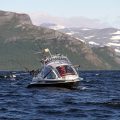
Using a fish finder to look for fish is not difficult, but requires some practice, and some time
to get used to it. The first thing to do after buying a fish finder – read the
guide on how to use a fish finder. The guide may be uninteresting or contain
more technical information than reading, but it is impossible to stress how
important it is to understand the manual to identify the purchased device. The
next thing you must do is install the fish finder and know how to use a fish
finder. Regardless of whether you are using a Hebrew Loader, a low-speed
installation tool, a physical installation device, or a portable installation
tool, your guide will help you complete all the steps necessary to install the
model correctly. If in doubt, consult a professional or do this for you.
You are now ready to run the fish finder and prepare to catch more fish. When the device is
turned on for the first time, it will work in automatic mode, which means
programmed settings will be used. While exploring your model, you will be able
to switch to manual mode and adjust the parameters according to the fishing
conditions. First, leave the fish finder on the machine and rotate for five
minutes around the lake, bay, or ocean where you are fishing. Watch the screen
always to feel what you see. Do not worry about fishing or understanding
everything that is being offered right now this will come with experience.
Now start setting up one function at a time and learn about each feature. One of the key
settings you can play with is setting sensitivity. When you adjust the
sensitivity of the device, you can adjust the power of the fish finder — simple
base: low power (sensitivity), low image quality on screen. Experts recommend a
sensitivity of 75 to 100%. Trial and error will be the best way to determine
the optimal settings for your model.
The next setting you need to visit in manual mode is set the fish ID. Once you feel your
device, turn off the fish selection function and try to get used to reading the
fish bows you will typically see on the screen. The fish icons displayed in the
Fish ID are useful for beginners, but once you begin to recognize the screen,
it is best to learn how to read the natural fish bows. The fish bow will give
you a more accurate idea of what is underwater.
It is better to use another feature after these first ones, Auto Depth, in a preprogrammed
setting when you start using the Sound Echo tool. Using a pre-programmed
setting will tell the device that it must automatically follow the bottom,
preferably when using the sonar for the first time. When you become an expert,
you can set the upper and lower limits of the display frame manually. The lower
the display window you set, the better the resolution. As a general rule,
experienced fishers eliminate many of the upper feet of water and stop scanning
about 10 feet below the real bottom. Of course, the size of the display window
depends on the depth of the water and the type of fish you want to catch. Try
the size of the display window so you feel comfortable with the amount of water
you can display and the image accuracy.
When you recognize the fish finder more and more, you will notice the horizontal line
across the screen, and learn how to use a fish finder better. This line is a
depth indicator and can be moved up or down in the display. When you find a
fish, adjust the depth indicator to cut the fish bows, and the device will tell
you exactly how deep the fish is. Now you know precisely how to drop the deep test.
The last post that should be mentioned in this article is the suppressor setting. This
parameter tells the device that the background noise should be filtered.
Getting rid of background noise can be helpful, but if the sensor is installed
correctly, this is not usually required. If you find that you need to use the
condenser to detect the fish, you should check that the sensor is installed
correctly. In general, you want to turn off the suppressor, where the
suppressor value can completely block the sonar signal, or you will not find
the fish that way.
At first glance, the use of the fish finder may seem somewhat complicated, but, like
everything else in life, it just takes practice. Do not be afraid to experiment
with your model, try out other settings and see what happens. Experience and
error will eventually help you customize the fish finder according to the
perfect configuration for your fishing experience. This will help you to
understand how to use a fish finder well. Before you know it, you’ll find more
fish than you know how to fish. Remember you need to practice with this just
like with your rod and reel.











